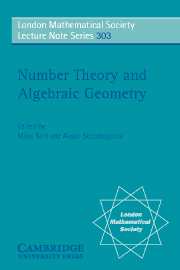Book contents
- Frontmatter
- Contents
- In Lieu of Birthday Greetings
- Peter Swinnerton-Dyer's mathematical papers to date
- On the Hasse principle for bielliptic surfaces
- Effective Diophantine approximation on Gm
- A Diophantine system
- Valeurs d'un polynôme à une variable représentées par une norme
- Constructing elements in Shafarevich–Tate groups of modular motives
- A counterexample to a conjecture of Selmer
- Linear relations amongst sums of two squares
- Kronecker double series and the dilogarithm
- On Shafarevich–Tate groups and the arithmetic of Fermat curves
- Cascades of projections from log del Pezzo surfaces
- On obstructions to the Hasse principle
- Abelian surfaces with odd bilevel structure
Constructing elements in Shafarevich–Tate groups of modular motives
Published online by Cambridge University Press: 04 August 2010
- Frontmatter
- Contents
- In Lieu of Birthday Greetings
- Peter Swinnerton-Dyer's mathematical papers to date
- On the Hasse principle for bielliptic surfaces
- Effective Diophantine approximation on Gm
- A Diophantine system
- Valeurs d'un polynôme à une variable représentées par une norme
- Constructing elements in Shafarevich–Tate groups of modular motives
- A counterexample to a conjecture of Selmer
- Linear relations amongst sums of two squares
- Kronecker double series and the dilogarithm
- On Shafarevich–Tate groups and the arithmetic of Fermat curves
- Cascades of projections from log del Pezzo surfaces
- On obstructions to the Hasse principle
- Abelian surfaces with odd bilevel structure
Summary
Abstract
We study Shafarevich–Tate groups of motives attached to modular forms on Γ0(N) of weight ≥ 2. We deduce a criterion for the existence of nontrivial elements of these Shafarevich–Tate groups, and give 16 examples in which a strong form of the Beilinson–Bloch conjecture would imply the existence of such elements. We also use modular symbols and observations about Tamagawa numbers to compute nontrivial conjectural lower bounds on the orders of the Shafarevich–Tate groups of modular motives of low level and weight ≤ 12. Our methods build upon the idea of visibility due to Cremona and Mazur,but in the context of motives rather than abelian varieties.
Introduction
Let E be an elliptic curve defined over ℚ and L(E, s) the associated L-function. The conjecture of Birch and Swinnerton-Dyer predicts that the order of vanishing of L(E, s) at s = 1 is the rank of the group E(ℚ) of rational points, and also gives an interpretation of the leading term in the Taylor expansion in terms of various quantities, including the order of the Shafarevich–Tate group of E.
Cremona and Mazur look, among all strong Weil elliptic curves over ℚ of conductor N ≤ 5500, at those with nontrivial Shafarevich–Tate group (according to the Birch and Swinnerton-Dyer conjecture). Suppose that the Shafarevich–Tate group has predicted elements of prime order p.
- Type
- Chapter
- Information
- Number Theory and Algebraic Geometry , pp. 91 - 118Publisher: Cambridge University PressPrint publication year: 2004
- 6
- Cited by

